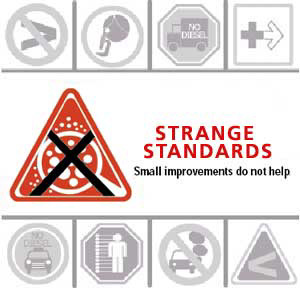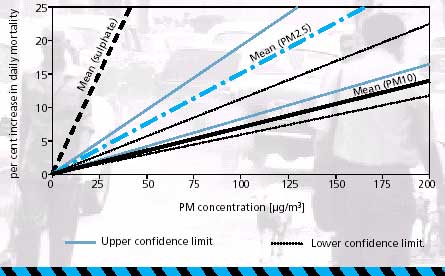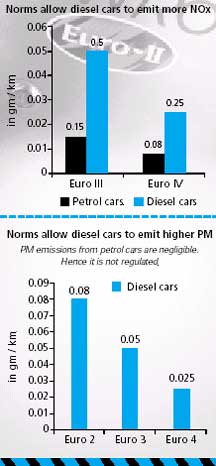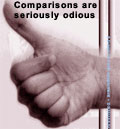|
 India is in the
process of adopting Euro II standards; next year, some cities will ‘evolve’ to
Euro III norms (enforced in Europe in 2000). For the government, the process of adopting
these standards is the be-all and end-all of pollution control measures. But the truth is
that it inadequately addresses the growing problem of diesel toxicity.
India is in the
process of adopting Euro II standards; next year, some cities will ‘evolve’ to
Euro III norms (enforced in Europe in 2000). For the government, the process of adopting
these standards is the be-all and end-all of pollution control measures. But the truth is
that it inadequately addresses the growing problem of diesel toxicity.
The emission standards we are adopting — inheriting wholesale and unthinkingly from Europe — legally allow diesel vehicles to emit more particulate matter and nitrogen oxides (NOx) than petrol cars. Ironically, these are precisely the most serious of our worries. Euro II norms allow diesel cars to combinedly emit 40 per cent more NOx and hydrocarbons than petrol cars (see graph: What norms allow). Even Euro IV standards, to be enforced in Europe from 2005, allow diesel cars to emit three times more NOx than petrol cars. Since particulate emissions from petrol cars are negligible, it is not even regulated. While it is true that petrol cars are allowed to emit more carbon monoxide than diesel vehicles, health concerns over diesel particulates are far greater.
But Europe is already working to correct such anomalies, and the US has begun phasing-in stringent fuel neutral standards: all cars, irrespective of the fuel used, must meet the same stringent standards.
| GREAT DANGER: The Oxidation Catalyst generates more sulphate particles even with low sulphur fuels |
 |
| Source: Shawn D.Whitacre, Diesel Fuel Sulphur Effects on the Performance of DOCs, Cummins, Inc. August 24, 2000, Diesel Engine Emissions Reduction Workshop, USA |
But in India
In India, the emphasis continues to be on ineffectual intermediate steps. Indeed, the
adoption of Euro II and Euro III standards — whose strategy largely hinges on using
reduced sulphur levels (from 500 ppm to 350 ppm next year, but only in some cities) in
combination with diesel oxidation catalysts (DOC) — is likely to increase health
risks. DOC oxidises almost all fuel sulphur and lead to deadlier and more toxic sulphate
particles. Paradoxically, sulphate emissions from a young and expanding fleet — old
vehicles do not even have any such gizmo fitted in them — will form a large part of
total diesel particulate emissions
WHO says, sulphate particles are more harmful than PM10 (see graph: Death by PM). It says that sulphate particles are the major factor in causing more hospital admissions, and mortality. An increase of 10 µg/cum of sulphates in the air can increase hospital admissions and daily mortality by as much as 50-60 per cent.
By 2005, most diesel vehicles in Delhi will be fitted with oxidation catalysts running on low sulphur fuels like 350 ppm, in order to meet the Euro III standards but, as scientific evidence shows, this will increase harmful sulphate emissions.
A study by the US Department of Energy and its National Renewable Energy Laboratory conducted under the programme, ‘Diesel Emission Control-sulphur Effects Project (DECSE)’, shows that at high temperatures and high-speed operations, the use of 350 ppm sulphur fuel triples PM emissions from the tailpipe over the engine out emissions#.
This increase is due to sulphate particles; a diesel oxicat, when used in combination with moderately high sulphur fuel, therefore dramatically increases the number of harmful sulphate particles.
| GREAT DANGER: The Oxidation Catalyst generates more sulphate particles even with low sulphur fuels |
 |
| Source: Shawn D. Whitacre, Diesel Fuel Sulphur Effects on the Performance of DOCs, Cummins, Inc. August 24, 2000, Diesel Engine Emissions Reduction Workshop, USA |
The DECSE test was conducted on a Cummins ISM370 engine fitted with diesel oxi-cats. Four different qualities of diesel sulphur — 3 ppm, 30 ppm, 150 ppm and 350 ppm — were used Test results clearly indicated that there was no apparent reduction in total particulate emissions. On the contrary, sulphate particles in exhaust fumes increased dramatically after the exhaust passed through the oxidation catalyst (see graph: Great danger).
More research has shown that when efforts are made to improve diesel engines to reduce the total quantity of particulate matter in diesel exhaust, the particles become smaller and their numbers go up drastically: this poses a serious health risk. Ironically, when the quality of a diesel engine is poor and its exhaust is full of carbon particles, it acts like a sponge and soaks up the volatile organic and sulphate compounds – thereby preventing them from forming particles of their own. But when the engine is of a better quality and the quantity of carbon particles is reduced, the volatile organic compounds and sulphur compounds form extremely tiny particles of their own, including the highly acidic sulphate particles. Only the most drastic technical measures, which the US and Europe are adopting today, can address this complex challenge.
Clean dieselWhat is the clean diesel the world is moving to? Regulators will understand how lax the current Euro II emissions standards are once they consider that these norms — for particulate matter emissions from heavy-duty vehicles and cars — are respectively 86.67 per cent and 68.7 per cent more lenient than the corresponding Euro IV norms ( to be enforced in Europe in 2005).
| WHAT NORMS ALLOW: Poison |
 |
Indeed, even the Euro IV standards lag behind the global best, such as the US is phasing in 2004 onwards. The US Tier II standards for commercial vehicles, for instance, are approximately 80 per cent tighter than Euro IV norms. They are 90 per cent tighter for NOx and 60 per cent tighter for PM than even the proposed Euro V limits. The point is that Western regulators have tightened emissions standards, to enable aggressive innovation that leads to improved diesel technology. New engine developments and catalyst technology, like diesel particulate filters, can achieve 95 per cent efficiency in reducing particulate matter. But to operate effectively, the technology require fuel with near-zero sulphur.
The International Council on Clean Transportation (ICCT) — a global forum of leading air quality regulators and experts — cites studies to show that the continuously regenerating diesel particulate filter and the catalysed diesel particulate filter can achieve 95 per cent efficiency in particulate emissions control if used with 3 ppm sulphur fuel. This efficiency will drop to zero if 150 ppm sulphur fuel is used, and particulate emissions may double (over the baseline) with 350 ppm sulphur fuels. This is the kind of diesel emission targets the world is chasing to address diesel emissions.
Global best standards are phasing in diesel fuel with less than 10-15 ppm sulphur content to enable use of advanced engine designs and emissions control technologies, like particulate traps and NOx adsorbers. It is this combination of fuel and emission control technologies that eliminates both particle mass and numbers by nearly 99 per cent. ICCT has recently issued a statement calling sulphur the "lead of the new century". It has warned governments that sulphur threatens to become the next major obstacle to clean air, since it impedes the introduction of a new generation of engine and emission control technologies, globally.
Even in India, Supreme Court has intervened to define clean fuel standards. In response to the Supreme Court directive, the Environment Pollution (Prevention and Control) Authority (EPCA) has defined clean diesel as follows: "Ultra-low sulphur diesel (ULSD) with 0.001 per cent (10 ppm) sulphur and low PAH content will be significantly less polluting provided it is used in combination with particulate traps. It will also be necessary to undertake measures so that ULSD does not get adulterated with low quality diesel or other adulterants. In such a situation, ULSD can be regarded as an environmentally acceptable fuel."# Unfortunately, there exists no plan to phase-in fuel of such quality.
